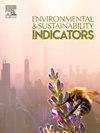Optimization of land use structure integrating ecosystem service function and economic development—A case study in Dongting Lake Ecological and Economic Zone, China
IF 5.4
Q1 ENVIRONMENTAL SCIENCES
引用次数: 0
Abstract
Currently, land use simulation and optimization show a trend towards spatialization and intelligence. However, regional land use simulation and optimization often neglects the inherent uncertainty of the land use system and the actual impacts of land use practices on the ecological environment. Therefore, this study established a coupled land use simulation and optimization model based on ecosystem services and economic development, which integrates the ecosystem service evaluation model (InVEST), the interval uncertainty optimization model, and the spatial layout model of land use (PLUS), to simulate and optimize the land use allocation planning practice of Dongting Lake Ecological and Economic Zone in 2030. The objective of the coupled model is to aim at realizing regional ecological benefits and socio-economic benefits while taking into account the ecosystem service function constraints (water production, water conservation, soil and water conservation, and carbon storage), environmental protection constraints (air, water, and solid waste pollution), economic constraints (water use limitation, electricity use limitation), social constraints (food safety, fertilization), and technological constraints (total land area). economic benefits of the region. The modeling results show that the economic benefits of the optimized Dongting Lake Eco-Economic Zone range between [15622.72 × 108,19150.50 × 108] CNY, and the optimized areas of farmland, woodland, grassland, water area, construction land, and unutilized land are[25686.99,25932.61]km2, [22093.37,22295.23]km2,[837.11108,841.41]km2,[7536.86,7767.01]km2,[2660.92,2987.49]km2,[1090.72,1116.36]km2.and the ecosystem service function, pollutant emission level and ecosystem service value of the optimized Dongting Lake Eco-Economic Zone in the optimization scenario, which guarantees higher economic benefits than the status quo scenario, show a better performance than the status quo scenario as a whole. Finally, by spatially allocating the optimization results, the coupled model provides a new perspective and tool for decision-makers to develop sustainable regional land use planning.
求助全文
约1分钟内获得全文
求助全文
来源期刊

Environmental and Sustainability Indicators
Environmental Science-Environmental Science (miscellaneous)
CiteScore
7.80
自引率
2.30%
发文量
49
审稿时长
57 days
 求助内容:
求助内容: 应助结果提醒方式:
应助结果提醒方式:


